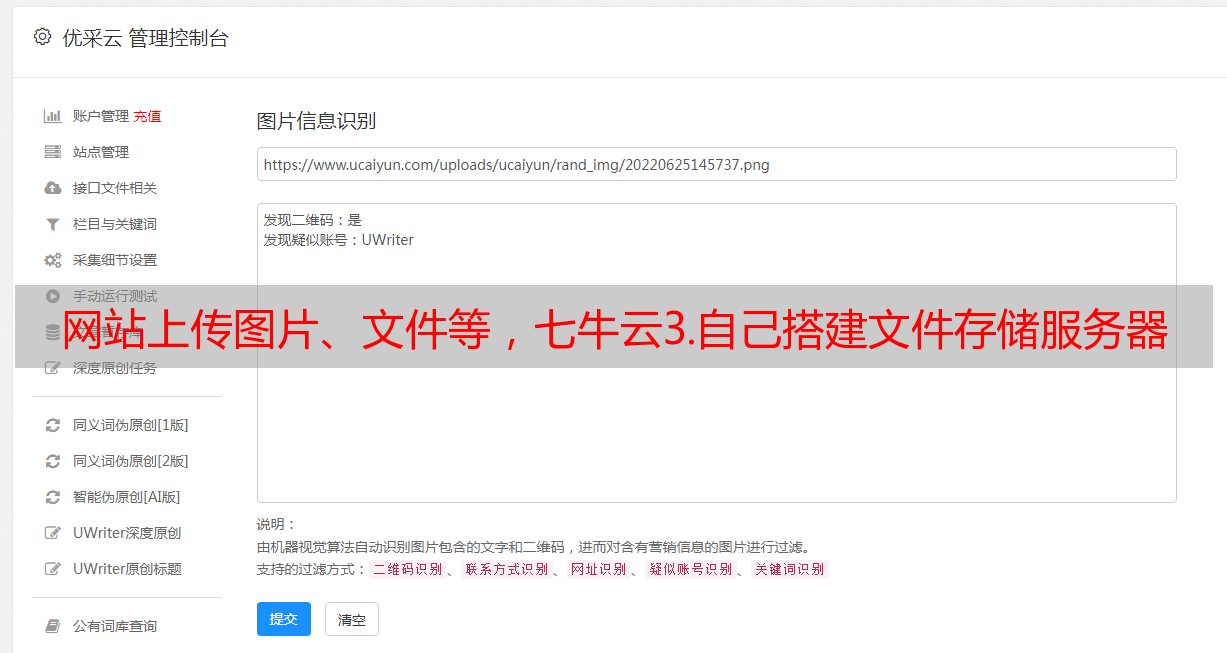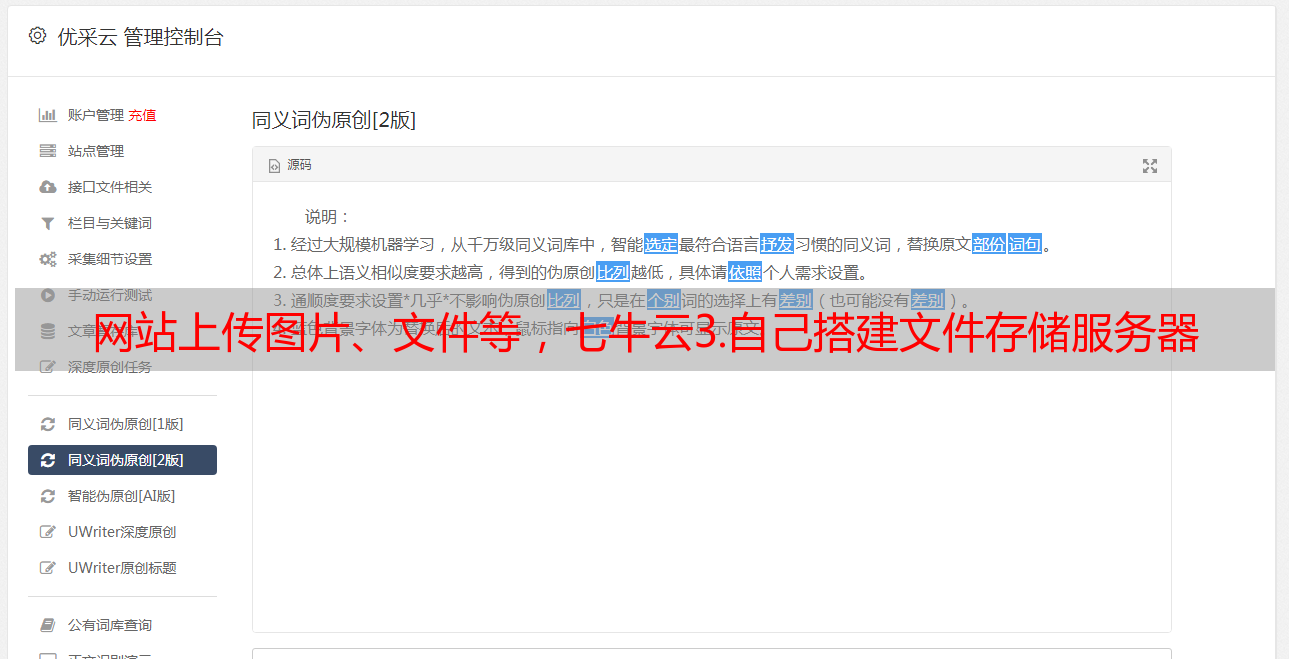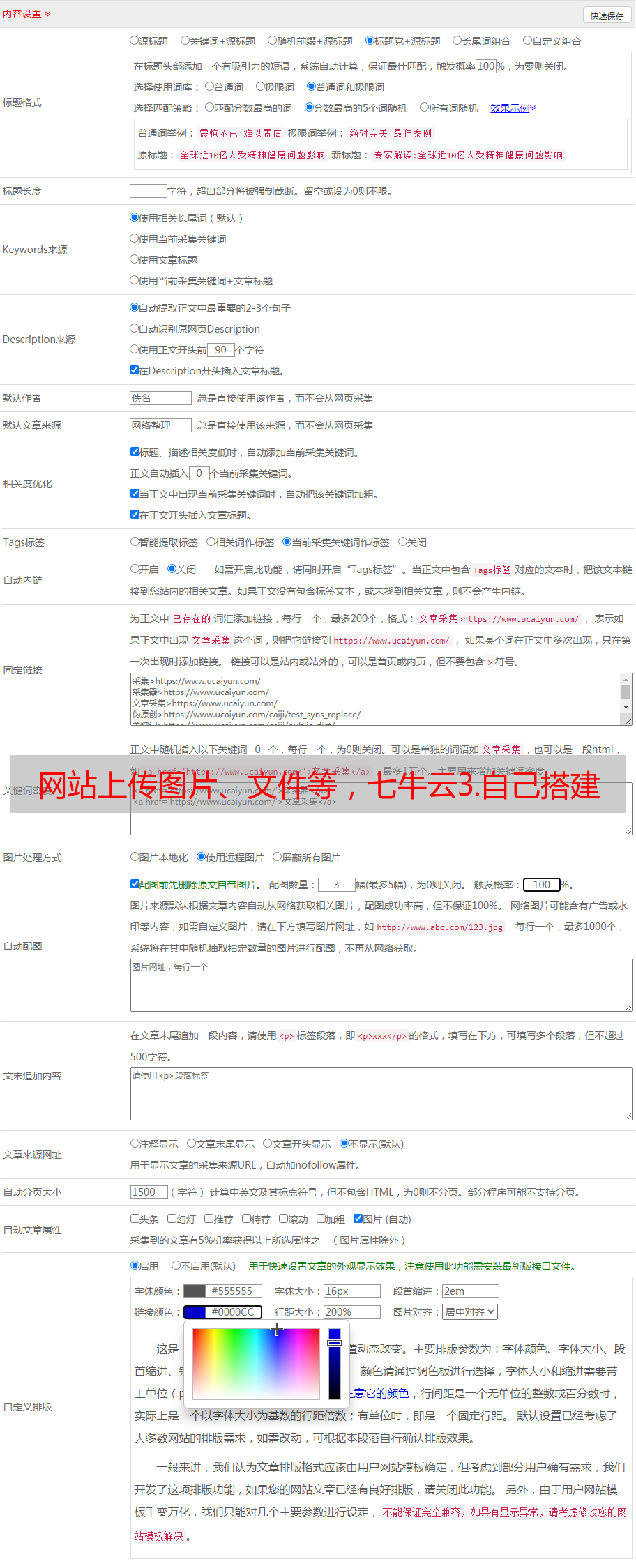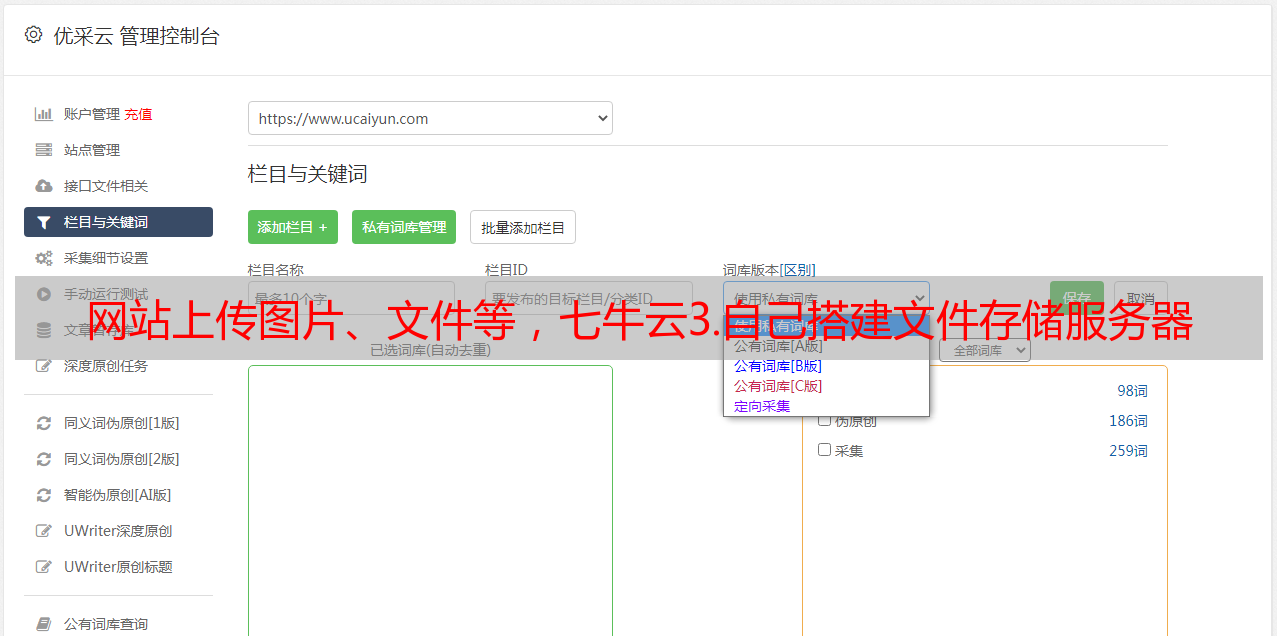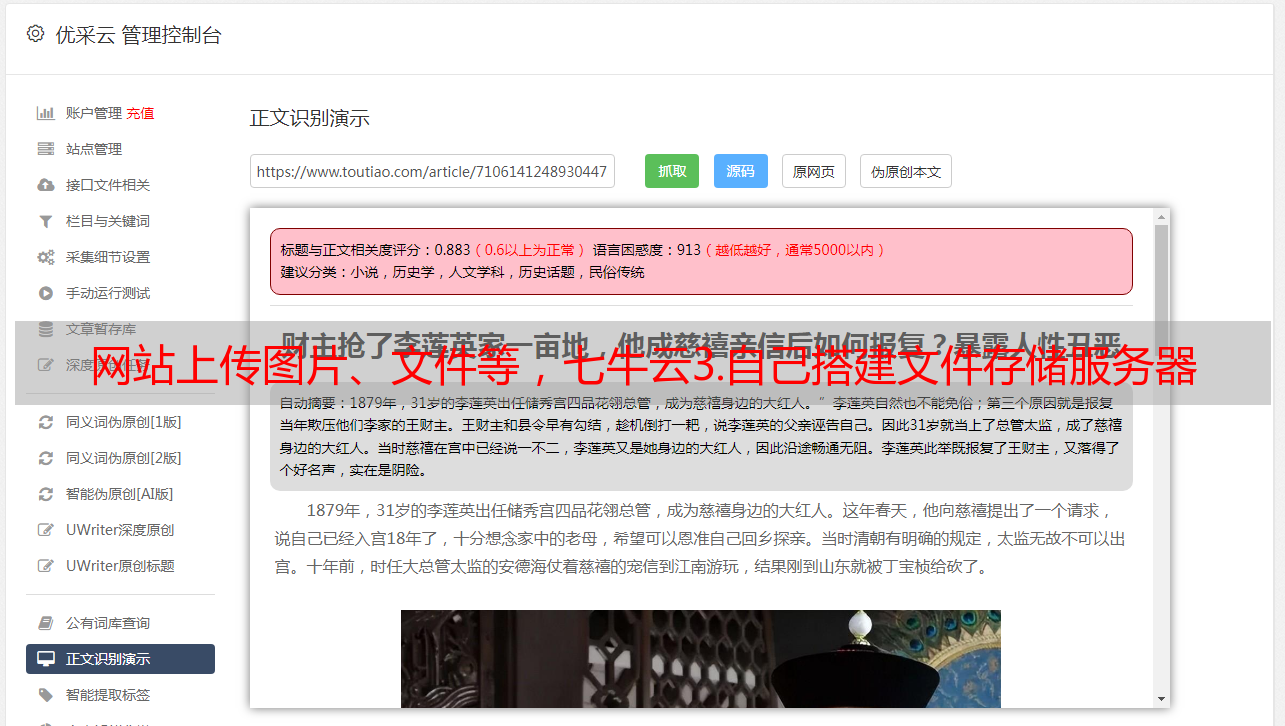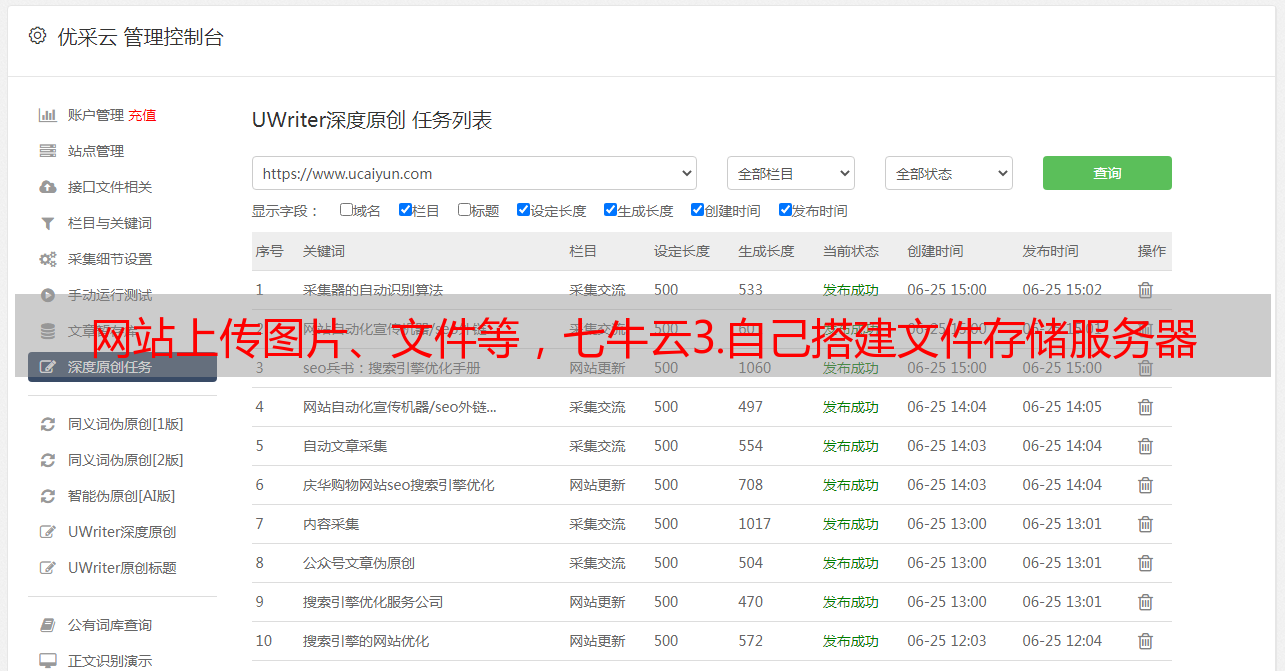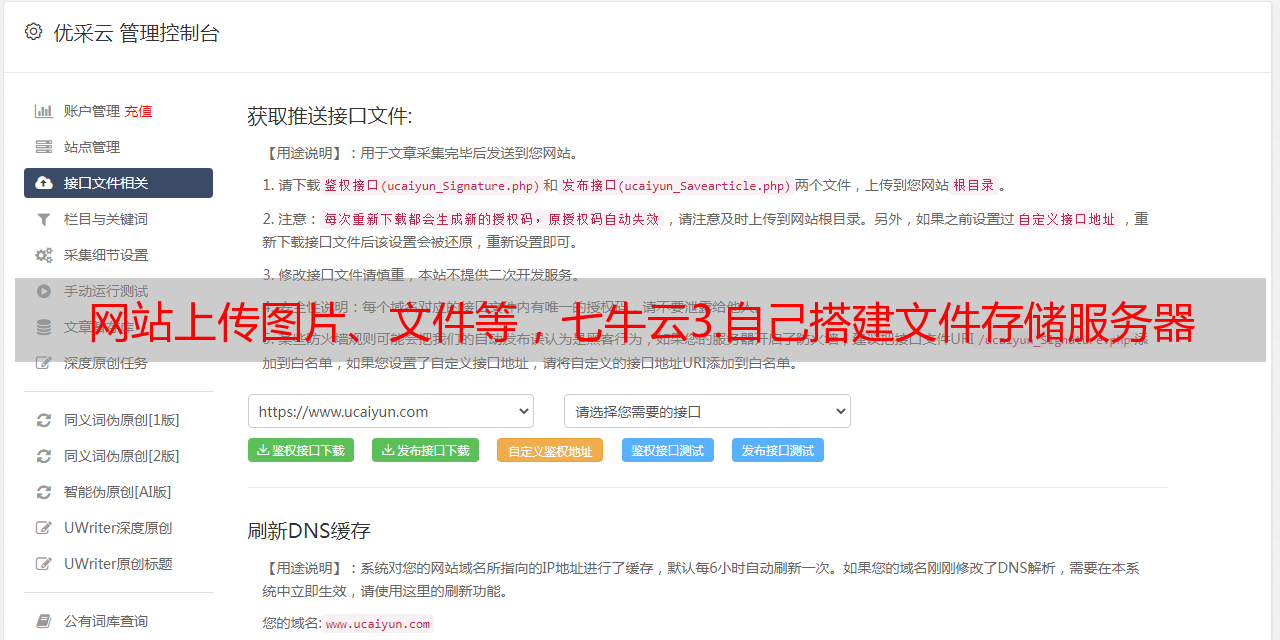网站上传图片、文件等,七牛云3.自己搭建文件存储服务器
优采云 发布时间: 2021-04-01 21:01网站上传图片、文件等,七牛云3.自己搭建文件存储服务器
网站上传图片,文件等。最常见的方法是将它们直接上传到服务器的webapp目录,或直接上传到服务的指定文件夹。对于简单的独立应用程序,此方法确实非常方便且简单,并且问题较少。但是,对于分布式项目,直接上载到项目路径的方法显然是不可靠的,并且随着业务量的增加,文件将增加,并且服务器上的压力自然会增加。这是对您了解的有关保存文件的几种方式的简要介绍。
1.直接上传到指定的服务器路径;
2.上传到第三方内容存储,这是将图片保存到Qiniu Cloud的方法
3.构建自己的文件存储服务器,例如FastDFS,FTP服务器等。
最简单的上传
首先,解释项目结构为SpringBoot + mybatis。由于该项目以jar形式打包,因此图片保存在此处的指定目录中。
添加WebAppConfig配置类
@Configuration
public class WebAppConfig extends WebMvcConfigurerAdapter{
/**
* 在配置文件中配置的文件保存路径
*/
@Value("${img.location}")
private String location;
@Bean
public MultipartConfigElement multipartConfigElement(){
MultipartConfigFactory factory = new MultipartConfigFactory();
//文件最大KB,MB
factory.setMaxFileSize("2MB");
//设置总上传数据总大小
factory.setMaxRequestSize("10MB");
return factory.createMultipartConfig();
}
}
文件上传的方法。此方法的某些参数可能需要简单地修改。通常,首先使用文件保存路径处理文件,然后将文件保存到该路径,最后返回文件上传信息。
@PutMapping("/article/img/upload")
public MarkDVo uploadImg(@RequestParam("editormd-image-file") MultipartFile multipartFile) {
if (multipartFile.isEmpty() || StringUtils.isBlank(multipartFile.getOriginalFilename())) {
throw new BusinessException(ResultEnum.IMG_NOT_EMPTY);
}
String contentType = multipartFile.getContentType();
if (!contentType.contains("")) {
throw new BusinessException(ResultEnum.IMG_FORMAT_ERROR);
}
String root_fileName = multipartFile.getOriginalFilename();
logger.info("上传图片:name={},type={}", root_fileName, contentType);
//处理图片
User currentUser = userService.getCurrentUser();
//获取路径
String return_path = ImageUtil.getFilePath(currentUser);
String filePath = location + return_path;
logger.info("图片保存路径={}", filePath);
String file_name = null;
try {
file_name = ImageUtil.saveImg(multipartFile, filePath);
MarkDVo markDVo = new MarkDVo();
markDVo.setSuccess(0);
if(StringUtils.isNotBlank(file_name)){
markDVo.setSuccess(1);
markDVo.setMessage("上传成功");
markDVo.setUrl(return_path+File.separator+file_name);
markDVo.setCallback(callback);
}
logger.info("返回值:{}",markDVo);
return markDVo;
} catch (IOException e) {
throw new BusinessException(ResultEnum.SAVE_IMG_ERROE);
}
}
文件保存类
/**
* 保存文件,直接以multipartFile形式
* @param multipartFile
* @param path 文件保存绝对路径
* @return 返回文件名
* @throws IOException
*/
public static String saveImg(MultipartFile multipartFile,String path) throws IOException {
File file = new File(path);
if (!file.exists()) {
file.mkdirs();
}
FileInputStream fileInputStream = (FileInputStream) multipartFile.getInputStream();
String fileName = Constants.getUUID() + ".png";
BufferedOutputStream bos = new BufferedOutputStream(new FileOutputStream(path + File.separator + fileName));
byte[] bs = new byte[1024];
int len;
while ((len = fileInputStream.read(bs)) != -1) {
bos.write(bs, 0, len);
}
bos.flush();
bos.close();
return fileName;
}
配置文件保存路径
测试:直接使用邮递员上传
以下需要访问和预览上传的图片
在配置文件中添加静态资源的配置。 SpringBoot对静态的处理,Springboot的静态资源路径配置
然后在浏览器的链接栏中键入:图片应在此处忽略
上传到Qiniu Cloud
在这里,您必须首先在Qiniu Cloud中注册一个帐户并打开对象存储空间。免费用户拥有10G的存储空间。教程:
然后在您自己的项目中设置环境:使用maven指导软件包
com.qiniu
qiniu-java-sdk
[7.2.0, 7.2.99]
然后找到刚才创建的密钥,将其复制并保存在项目资源文件中
此处的存储桶是上面存储空间的名称,而路径是域名。
上传工具:
@Component
public class QiniuUtil{
private static final Logger logger = LoggerFactory.getLogger(QiniuUtil.class);
@Value("${qiniu.accessKey}")
private String accessKey;
@Value("${qiniu.secretKey}")
private String secretKey;
@Value("${qiniu.bucket}")
private String bucket;
@Value("${qiniu.path}")
private String path;
/**
* 将图片上传到七牛云
* @param file
* @param key 保存在空间中的名字,如果为空会使用文件的hash值为文件名
* @return
*/
public String uploadImg(FileInputStream file, String key) {
//构造一个带指定Zone对象的配置类
Configuration cfg = new Configuration(Zone.zone1());
//...其他参数参考类注释
UploadManager uploadManager = new UploadManager(cfg);
//...生成上传凭证,然后准备上传
// String bucket = "oy09glbzm.bkt.clouddn.com";
//默认不指定key的情况下,以文件内容的hash值作为文件名
try {
Auth auth = Auth.create(accessKey, secretKey);
String upToken = auth.uploadToken(bucket);
try {
Response response = uploadManager.put(file, key, upToken, null, null);
//解析上传成功的结果
DefaultPutRet putRet = JSON.parseObject(response.bodyString(), DefaultPutRet.class);
// DefaultPutRet putRet = new Gson().fromJson(response.bodyString(), DefaultPutRet.class);
// System.out.println(putRet.key);
// System.out.println(putRet.hash);
String return_path = path+"/"+putRet.key;
logger.info("保存地址={}",return_path);
return return_path;
} catch (QiniuException ex) {
Response r = ex.response;
System.err.println(r.toString());
try {
System.err.println(r.bodyString());
} catch (QiniuException ex2) {
//ignore
}
}
} catch (Exception e) {
e.printStackTrace();
}
return "";
}
}
上传界面方法
/**
* 上传文件到七牛云存储
* @param multipartFile
* @return
* @throws IOException
*/
@PutMapping("/article/img/qiniu")
public String uploadImgQiniu(@RequestParam("editormd-image-file") MultipartFile multipartFile) throws IOException {
FileInputStream inputStream = (FileInputStream) multipartFile.getInputStream();
User currentUser = userService.getCurrentUser();
String path = qiniuUtil.uploadImg(inputStream, currentUser.getUsername()+"_"+Constants.getUUID());
return path;
}
测试
将文件上传到FastDFS
首先,您需要构建一个FastDFS服务器,这里将不再介绍。门户:Linux下FastDFS系统的构建
依赖性
com.github.tobato
fastdfs-client
1.25.4-RELEASE
添加配置信息
FastDFS配置类
@Configuration
@ComponentScan(value = "com.github.tobato.fastdfs.service")
@Import(FdfsClientConfig.class)
@EnableMBeanExport(registration = RegistrationPolicy.IGNORE_EXISTING)
public class FastDfsConfig {
}
这里,FastDFS文件的操作仅处理上传,上传文件类型:
@Autowired
private FastFileStorageClient storageClient;
@Autowired
private FdfsWebServer fdfsWebServer;
@PutMapping("/article/img/fdfs")
public String uploadImgfdfs(@RequestParam(value = "editormd-image-file") MultipartFile multipartFile) throws IOException {
StorePath storePath= storageClient.uploadFile(multipartFile.getInputStream(), multipartFile.getSize(), "png", null);
String path = storePath.getFullPath();
logger.info("保存路径={}",path);
return path;
}
测试:
参考:
